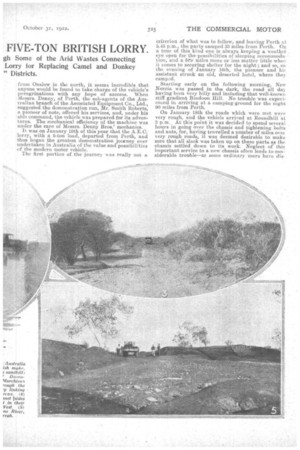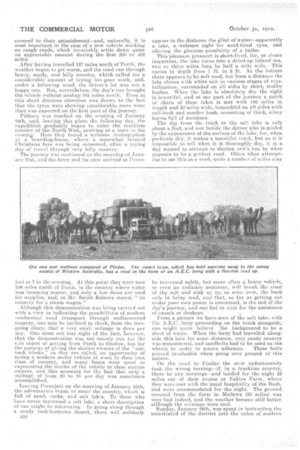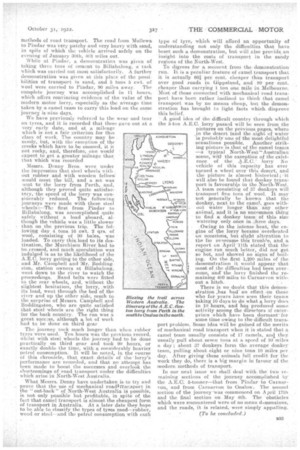ACROSS WEST AUSTRALIA FIVE-TON BRITISH LORRY.
Page 16

Page 17

Page 18

Page 19

If you've noticed an error in this article please click here to report it so we can fix it.
An Historic Demonstration Trip Undertal Perth with Onslow. The Capability of tl gh Some of the Arid Wastes Connecting Lorry for Replacing Camel and Donkey " Districts.
ALTHOUGH there are many hundreds of heavy commercial motor vehicles in service in foreign climes, working under conditions as opposite as the Poles, it is singular that in the country of their origin one hears so little of their activities. One does not for a moment question that these vehicles are worthily upholding the traditions of British manufacture, and the inordinate silence which surrounds their operation must be taken as a good sign—a sign reflective of the features of reliability and durability associated with the-products of the Mother Country. We have had a number of instances brought to our notice of the satisfactory use of British vehicles under conditions for Nvhich they were not primarily designed, and iii some cases they have blazed the trail between remote centres unposscssed of any connecting links whatever, and have thus opened a new vista of possibility before the modern motor vehiee. Some of these remarkable achievements deserve to rank high in the annals of the industry, but it is doubtful if any can claim to deserve the distinction which should fall to the lot of the A.E.C. 5-ton vehicle which, during the early part of the year, undertook a unique demonstration journey across the sandy and desolate wastes of Western Australia.. The actual trio was
spread over a period of some months, and. although it was actually started in the first month of the year it was not until the middle of May that the historic run was completed. We have been in possession of the facts of this interesting trip for some weeks past, but owing to the vast distance separating this country from the Australian Commonwealth, it has been impossible to secure pictures taken in the course of the run of outstanding incidents. We make no excuse for recounting the details of the trip, believing, as we do, that it will fire the imagination of those who have a knowledge of the conditions " down under" as well as those who have confidence in the British product. Upon studying the map of the _practically roadless and desert district separating Perth in the south from Onsiow in the north, it seems incredible that anyone would be found to take charge of the vehicle's peregrinations with any hope of success. When Messrs. Denny, of Perth, the sub-agents of the Australian branch of the Associated Equipment Co., Ltd., suggested the demonstration run, Mr. Smith Roberts, a pioneer of note, offered his services, and, under his able command, the vehicle was prepared for its adventures. The mechanical efficiency of the machine was under the care of Messrs. Denny Bros. mechanics. It was on January 16th of this year that the A.E.C.. lorry, with a 5-ton load, departed from Perth, and thus began the greatest demonstration journey ever undertaken in Australia of the value and possibilities of the modern motor vehicle.
The first portion of the journey was really not a criterion of what was to follow, and leaving Perth at 5.45 p.m., the party camped 33 miles from Perth. On a tour of this kind one is always keeping a weather eye open for the possibilities of sleeping accommodation, and a few miles more or less matter little when it conies to securing shelter for the night ; and so, oil the evening of January 16th, the pioneer and his assistant struck an old, deserted hotel, where they camped.
Starting early on the following morning, New Norcia was passed in the dark, the road all da..) having been very hilly and including that well-known stiff gradient Bindoon Hill. No trouble was exerienoed in arriving at a camping-ground for the night 90 miles from Perth.
On January 18th the roads which were met were very rough, and the vehicle arrived at Roundhill at 3 p.m. At this point it was decided to spend several hours in going over the chassis and tightening bolts and nuts, for, having travelled a number of miles ovei very rough roads, it was deemed desirable to make sure that all slack was taken up on these parts as the chassis settled down to its work. Neglect or this, important service to a new chassis often leads to considerable trouble—as some ordinary users have clis covered to their astonishment—and, naturally, it is most important in the case of a new vehicle working on rough roads, which invariably settle down quite an appreciable amount dnring the first 300 or 400 After having travelled 127 miles north of Perth, the weather began to get warm, and the road ran through heavy, sandy, and hilly country, which called for a considerable amount of trying low-gear work, and, under a following wind, the driver's lot was not a happy one. But, nevertheless, the day's run brought the vehicle without mishap 161 miles north. Even at this short distance attention was drawn to the fact that the tyres were showing considerably more wear than was expected on the first part of the journey.
Pithara was reached on the evening of January 19th, and, leaving this place the following day, the expedition gradually began to enter the trackless country of the North-West, arriving at a town in the (-veni.r.c. Here they found a welcome resting-place at a -boarding-house, where a somewhat belated Christmas fare was being consumed, after a trying clay of travel through very hilly country.
The journey was continued CM the morning of January 21st, and the lorry and its crew arrived at Peren
jori at 7 in the evening. At this point they were now 236 miles north of Perth, in the country where water was becoming scarce, and only a. few dams are used for supplies, and, as Mr. Smith Roberts stated, " no country for a steam wagon."
Although this demonstration was being carried out with a view to indicating the possibilities of modern mechanical road transport through undiscovered country, one may be inclined to think, from the foregoing diary, that a very small mileage is done per day. One must not lose sight of the fact, however, that the demonstration was not merely run fur the sle object of getting from Perth to Onslow, but for the purpose of giving the statioo owners of the " outback blocks," as they are called, an opportunity of seeing a modern motor vehicle at work in their own class ofcountry, and many hours were spent in expounding the merits of the vehicle to these station owners, and this accounts for firm fact that only a mileage of front 20 to 30 per day was sometimes accomplished.
Leaving Peren.jori on the morning of January 25th, the adventurers began to enter the country, which is full of sand, rocks, and salt lakes. To those who have never traversed a salt lake, a short de,scription of one might be interesting. In going along through a sandy rock-bestrewn desert, there will suddenly B31 appear in the distance the glint of water—apparently. a lake, a welcome sight for sand-tired eyes, and offering the glorious possibility of a bathe.
This -pleasant prospect is short-lived, for, on closer inspection, the lake turns into a dried-up inland sea, two or three miles long by half a mile wide. This varies in depth from I it. to 2 ft. At the bottom there appears to be soft mind, but from a distance the lake shines with white salt in various stages of crystallization, surrounded on all sides by short, stubby bushes. When the lake is absolutely dry the sight is beautiful, and at one part of the journey a. patch or chain of these lakes is met with 150 miles in length and 20 miles wide, bespeckIed on all sides with salt-bush and samfire bush, consisting of thick, slimy leaves full of moisture.
The dip from the track to the salt lake is onYy about a foot, and woe betide the driver who is inisled by the appearance of the surface of the lake, for, when perfectly dry, it makes a beautiful track, but as it is impossible to tell when it is thoroughly dry, it is a day wasted to attempt to shorten one's run by what appears to be a perfect road. Often when attempting to use this as a road, quite a number of miles may be traversed safely, but more often a. heavy vehicle, or even an ordinary motorcar, will break the crust of the salt and sink up to, or even over, the back axle in briny mud, and that, so far as getting out -under your own power is concerned, is the end of the day's journey, and one ha 'S to wait for the assistance of camels or donkeys.
From a picture we have seen of the salt lake, with t.Tte A.E.C. lorry proceeding on the track alongside, one might quite believe the background to be a sheet of water. When the lorry had travelled alongside this lake for some distance, very sandy country was encountered, and sandbelts had to be used on the wheels in order to secure adhesion. These belts proved invaluable when going over ground of this nature. .
On the road to Pindar the crew unfortunately took the wrong turning—if, in a trackless country, there be any turnings—and landed for the night 22 miles out of their course at Eakins Farm, where they were met with the usual hospitality of the Bush, and were accommodated for the night. The ground covered from the farm to Mullewa (33 miles) was very bad indeed, and the weather became still hotter although the evenings were cool. Sunday, January 29th, was spent in instructing the, uninitiated of the district into the value of modern
methods of road trans,port. The road from Mullewa. to Pinder was Very patchy and very heavy with sand, in spite of which the vehicle arrived safely on the evening of January 30th, 403 miles out. While at Pindar, a demonstration was given of taking three tons of cement to Billabalong, a task which was carried out most satisfactorily. A further demonstration was given at this place of the possibilities of transport in sand, and 5 tans 5 cwt. of wool were carried to Pinder, 90 miles away. The complete journey was accomplished in 11 hours, which offers convincing evidence of the value of the modern motor lorry, especially as the aVerage time taken by a camel team to carry this load on the same journey is nine days.
We have previously referred to the wear and tear an tyres, and it is recorded that these gave out at a very early date, and at a mileage which is not a fair criterion for this class of work. The country may be sandy, but, with the exceptionof the creeks which have to be @Dossed, it is not rocky, and, therefore, one would expect to get a greater mileage that that which was recorded
Messrs. Denny Bros. were under the impression that steel wheels without rubber and with wooden felines: would meet the bill, and a set was eent tothe lorry from Perth, and, although they proved quite satisfactory, the speed of the lorry was considerably reduced. The foHowing journeys were made with these steel wheels:—The first from Pinder to .13illabalong, was accomplished quite safely withouta load aboard, although the vehicle was a little slower than on the previous trip. The following day 4 tons, 16 cwt. 2 qrs. of wool, consisting of 30 bales,. Was, loaded. To carry this load to its destination, the Murchison River had to ha crossed, and much speculation was indulged is as to the likelihood of the A.E.C. lorry getting to the other side, and Mr. Campbell and •'Mr. Boddingston, station owners at Billabalong, went down to the river to watch the proceedings. Sand belts were fitted to the rear wheels, and, without the slightest hesitation, the lorry, .with its load, went through the bed of the river and up the other side, much to the surprise of Messrs. Campbell and Boddingeton„ who are quite satisfied that steel wheels are the right thing for the back country. The run was a great Mee 2SS, although a lot of work had to be done on third gear
The journey took much longer than when rubber tyres were used. Ten hours was the previous record, whilst with steel wheels the journey had to be done practically on third gear and took 20 hours, or exactly double the time, With a considerably heavier petrol consumption. It will be noted, in the course of this chronicle, that exact details of the lorry's performance are recorded, and that no attempt has been made to boost the successes and overlook the shortcomings of road transport under the difficulties which arise in North-West Australia.
What Messrs. Denny have undertaken is•to try and prove that the use of mechanical road)teeresport in the "out-back" of North-West Australia i possible, is not only possible but profitable in spite of the fact that camel transport is almost the cheapest form of transport in Australia. At a later date they hope to be able to classify the types of tyres used—rubber, wood or steel—and the petrol consumption with each
7,4T43-1,
CoOLTHAN
A0CLAht ARNO
`""e'claio
AK4ND TOwERS LYNDON ORIZE5T PLEYADE5 MNILY
type of tyre, which will afford an opportunity of understanding not only the difficulties that have beset such a demonstration, but will also provide, an insight into the costs of transport in the sandy regions of the North-West.
To digress for a moment from the demonstration run. It is a peCuliar feature of camel transport that it is actually 661 per cent. cheaper than transport over good roads in Gippsland,. and 80 per cent. cheaper than carrying 1 ton one mile in Melbourne. Most of those connected with mechanical road transport have been rather inclined to think that camel , transport was by no means cheap, but the demonstration has brought to light facts which, disprove this belief.
A good idea of the difficult country through which the 5-ton A.E.C. lorry passed will be seen from the pictures on the previous pages, where "in the desert land the sight of water is probably one of the most delightful
sensations possible. Another striking picture es that of the camel teams —a typical North-West-Australian scene, wit} the exception of the existence of the 4.E. C. lorry lio vehicle of this capacity has ever -welled a wheel over this desert; and thepicture is almost historical; -it will also be found that donkey transport is fayourahee in the firorth-West. A team consisting of 37 donkeys will transport five tons of wool. It may not generally be known that the donkey, next to the camel, goes without water longer than any other animal, and it is no uncommon thing to find a donkey team of this size watering only once in hew days.
• Owing to the intense heat, the engine of the lorry became overheated on occasions, but slight alteration to the far overcame this trouble, and a report on April 11th stated that the engine ran much better, did not get so hot, and showed no signs of boiling. On the first 1400 miles of the demonstration it would appear that A most of the difficulties had been over.
come, andthe lorry finished the re maining 400 miles to Carnarvon with
out a hitch.
There is no doubt that this demon stration ,has had' an effect on those who for years have seen their teams
taking 10 days to do what a lorry does
in 10 hours, and has produced some activity among the directors if enter prises which have been dormant • for
some time owing to the•difficult transport problem. Some idea will be gained of the merits of mechanical road transport when it is stated that e camel team usually consists of 17 camels, and they usually :pull about seven tons at a speed of 10 miles a day ; about 37 donkeys form the average donkey team, pulling about eight or nine tons 10 miles per day. After giving these animals full credit for the work they do, there is a big margin in favour of the modern methods of transport. • •
In our next issue we shall deal with the two remaining sections of the journey accomplished by the A.E.G. 5-tanner—that from Pinder to Carriervon,. and from Carnarvon to Onslow. The second section of the journey was commenced on A pril 17th and the final section on May 4th. The obstacles which were encountered were of no mean thmensions, and the roads, it is related, were simply appalling.
(To be concluded.)


































